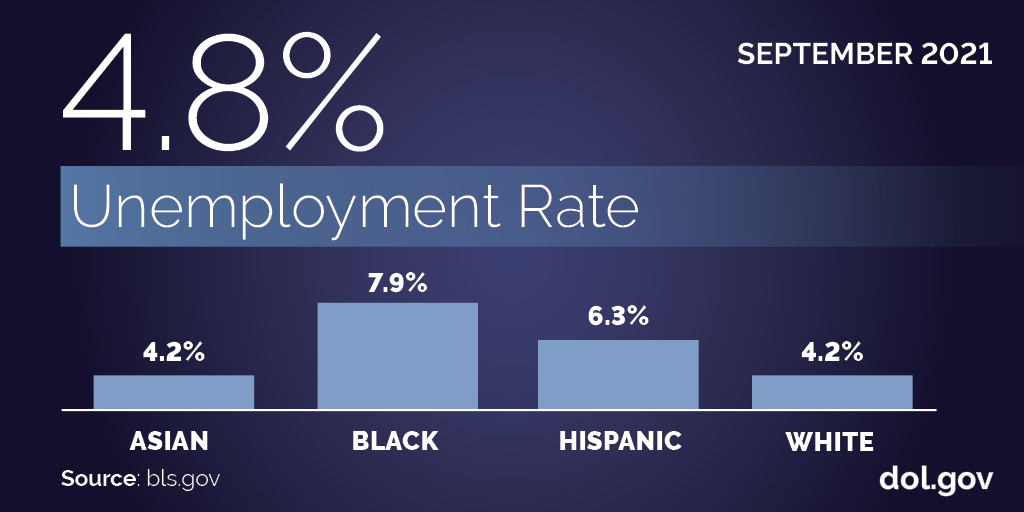
Today’s jobs report from the Bureau of Labor Statistics, much like the August report, shows a steady and consistent economic recovery, but with room for even stronger gains in certain areas. Employment rose by 194,000 and the unemployment rate dropped from 5.2% to 4.8%. Private sector growth was even stronger than those numbers indicate, with an increase of 317,000. But that growth was offset by a weak month in the government sector. The labor force participation rate is also hovering stubbornly at a basically steady 61.6%. To truly capture our full economic potential, that number needs to rise.
The need for bold economic investment is as urgent as ever, and President Biden’s Build Back Better agenda and the bipartisan infrastructure framework can accelerate our path to sustained growth and competitiveness, with focused efforts to lift up communities that have been historically slow to achieve economic stability in the aftermath of a crisis.
Here are five numbers from the September jobs report to pay attention to.
4.8%(rate)
Before the American Rescue Plan passed, the Congressional Budget Office projected that a return to an unemployment rate of 4.8% would not occur until 2023. Historic growth since then has put us in a much, much better place than expected. While individual months may fluctuate to some degree, and certain sectors may grow or lag as a result of a variety of factors, the trend since February is one of rapid recovery.
191,000
This was the 8-month peak in the daily coronavirus case rate on Sept. 1. The reference period for this report closely followed that peak, as cases were dropping but remained elevated.
We won’t have an economic recovery without first beating the pandemic. Public health must remain our priority and employer vaccine requirements are working to bring case numbers down and get more people back to work. Employer vaccine requirements, including those of the federal government, and supports like paid time off for vaccination are good for business and good for the prospects of our economy.
If you need a vaccine or a booster (or know someone who does) check out vaccines.gov to find a vaccination site near you.
+0.6%
Wages grew by 19 cents per hour on average, or 0.6%. Wage growth is good news for workers, especially those who have suffered stagnant wages for years. However, the rate of wage growth slowed this month. This means that while recovery efforts are taking hold, it’s no substitute for developing policies to build on economic growth and increase worker power in the long term.
-0.9%
We have kept a close eye on the unemployment rates by race, and the Black unemployment rate came down almost a full point since last month, from 8.8% to 7.9%. That’s significant, but we know that not all of that drop is because workers found jobs. Some also left the labor force. Sustained work to eliminate racial gaps will lead to decreases in the Black unemployment rate for the right reasons.
The unemployment rate also came down for whites, from 4.5% to 4.2%, and remained relatively unchanged for Asians (4.2%) and Hispanics (6.3%). Unemployment disparity trends across race and ethnicity mirror what we’ve seen in previous recessions and recoveries, but with a commitment to more inclusive policies, we can make this a moment where economic justice and equity is more fully realized than in the past.
-123,000
Government sector employment is down 123,000 jobs since August, which includes losses in local education support personnel such as crossing guards and cafeteria workers. These are the essential workers who are still, even now, helping us maintain our way of life and our children’s future through tremendous adversity. Local schools are on the front line in fighting COVID resurgence and these job losses will be a focus as we move forward.
Recovery continues, but the recent COVID resurgence illustrates the challenges that still remain. Behind these numbers are difficult day-to-day choices that workers and their families are making about their health, their jobs and their household budgets. Everything we do should be aimed at easing those burdens and giving them the tools to emerge from this pandemic stronger than before.
Janelle Jones is the chief economist of the U.S. Department of Labor.

 U.S. Department of Labor Blog
U.S. Department of Labor Blog